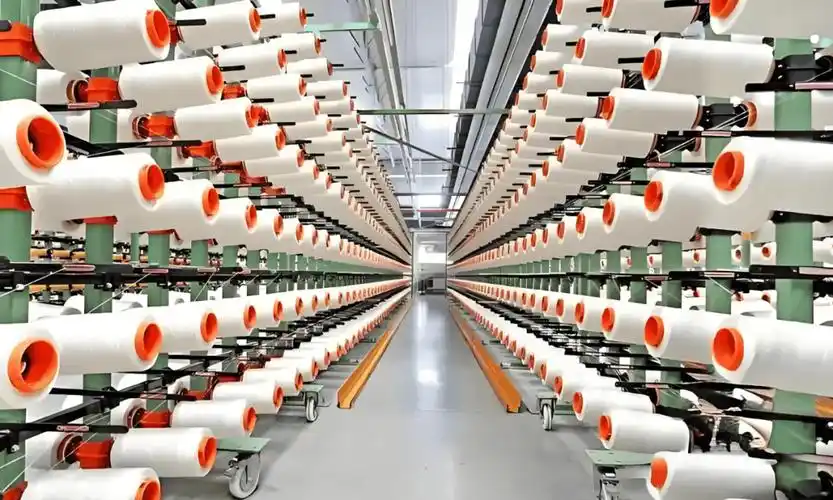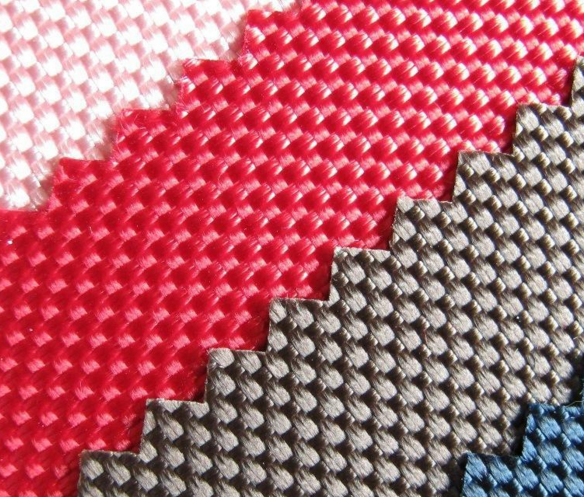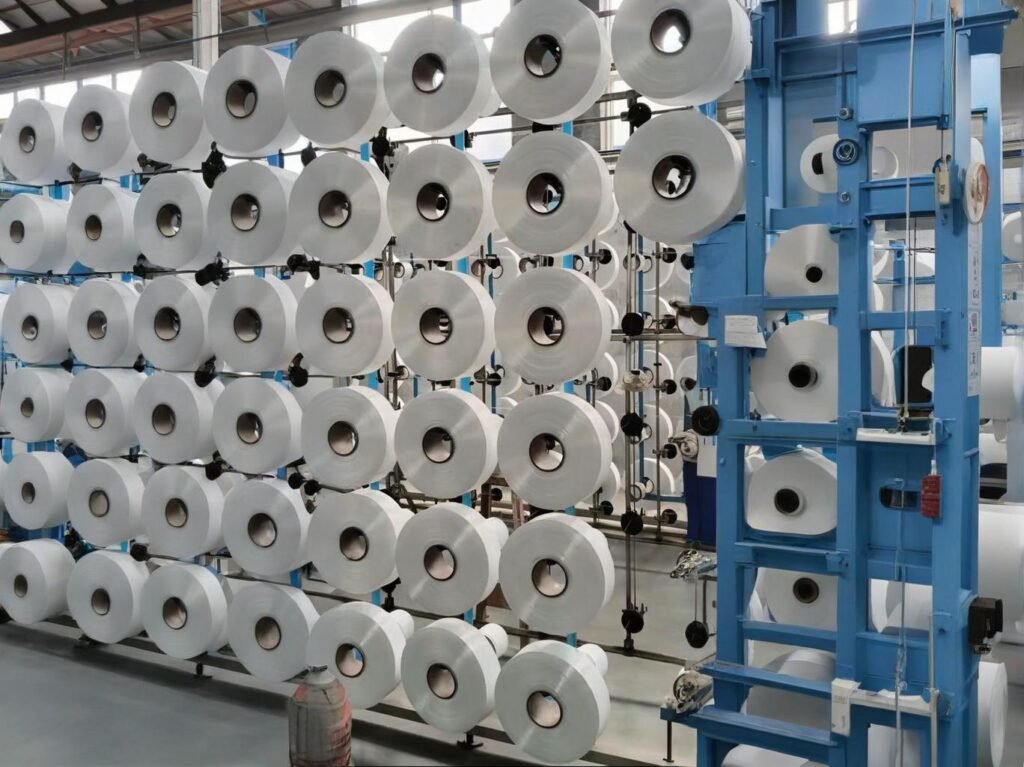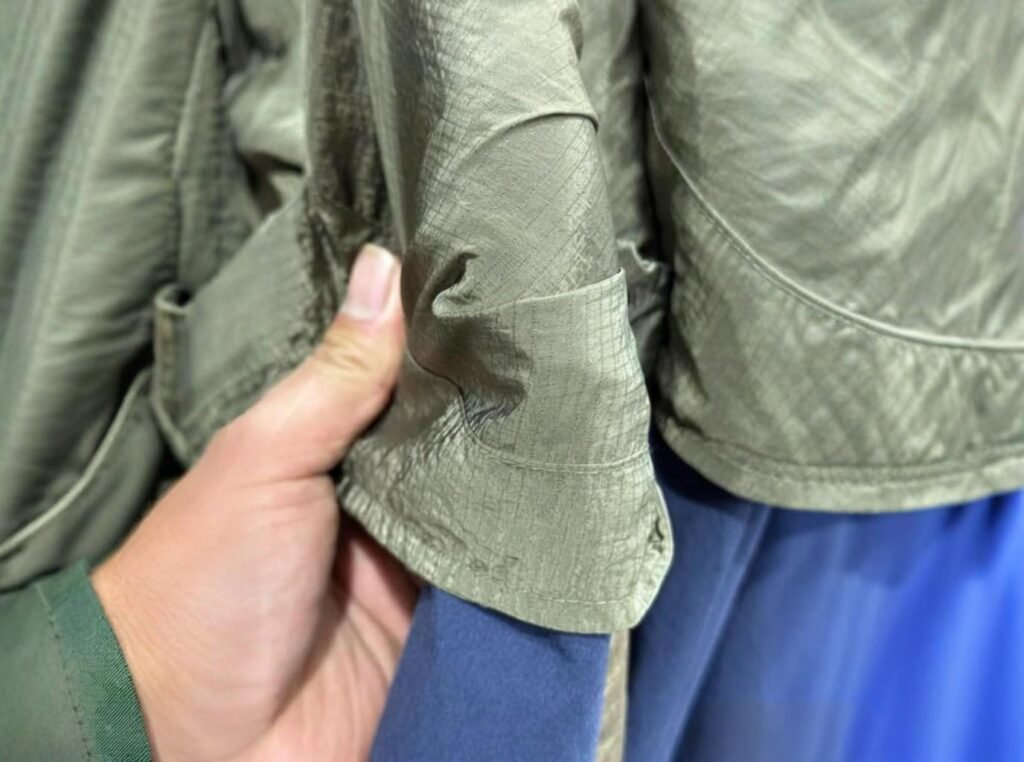
If you’ve ever worn a jacket, carried a backpack, driven a car, or even undergone medical treatment, chances are you’ve used nylon — one of the most versatile synthetic fibers ever developed. But despite nylon’s global dominance in textiles, many buyers, sourcing managers, and even some manufacturers don’t fully understand how nylon is made, where its raw materials come from, or how the production process directly impacts quality, durability, and price.
Nylon is made from petrochemical-derived monomers, primarily adipic acid and hexamethylene diamine (for Nylon 66) or caprolactam (for Nylon 6). These raw materials undergo a polymerization process that creates long-chain polyamides, which are then converted into fibers, films, or molded products for technical and industrial applications.
Understanding nylon’s raw materials and production process is crucial for any brand or buyer sourcing technical textiles. Whether you’re developing outdoor gear, industrial safety products, medical fabrics, or automotive components, knowing how nylon is produced gives you an edge in cost negotiation, supplier selection, and product quality control.
Let’s start with a real story: One of Szoneier’s European industrial clients once faced serious failures with imported nylon conveyor belts that cracked under stress. After a full root-cause analysis, we discovered that poor-quality nylon 6 yarns (produced from impure caprolactam batches) were the culprit. Once we re-engineered the production with high-purity raw materials, the belts’ lifespan doubled. This is exactly why understanding nylon’s raw material quality is not just academic — it’s critical business knowledge.
What Are the Main Raw Materials Used to Make Nylon?

Nylon is primarily made from petrochemical-derived monomers, with different grades depending on the type of nylon being produced. The two most common base raw materials are adipic acid + hexamethylene diamine (for Nylon 66) and caprolactam (for Nylon 6). Each offers distinct chemical structures that affect the performance of the final polymer.
Core Chemical Building Blocks of Nylon
1. Nylon 6 Raw Material: Caprolactam
- Caprolactam is a cyclic amide (lactam) with the formula (CH₂)₅C(O)NH.
- It is derived from cyclohexanone, which itself comes from benzene and other crude oil derivatives.
- Caprolactam purity (>99.9%) is essential to ensure high molecular weight and stable polymer chains.
2. Nylon 66 Raw Materials: Adipic Acid + Hexamethylene Diamine
| Component | Chemical Formula | Industrial Source |
|---|---|---|
| Adipic Acid | HOOC-(CH₂)₄-COOH | Derived from cyclohexane oxidation |
| Hexamethylene Diamine | H₂N-(CH₂)₆-NH₂ | Synthesized from adiponitrile (from butadiene and ammonia) |
The exact molar ratio of 1:1 is required for efficient condensation polymerization.
3. Alternative Bio-Based Options
Growing environmental concerns have led to the development of partially bio-based nylons:
| Type | Bio-Source | Availability |
|---|---|---|
| Nylon 11 | Castor oil (Ricinoleic acid) | Limited, high-end |
| Nylon 610 | Sebacic acid (from castor oil) + hexamethylene diamine | Expanding |
4. Minor Additives Used in Nylon Production
- Antioxidants (prevent degradation)
- Catalysts (speed up polymerization)
- Colorants (for solution dyeing)
- UV stabilizers (for outdoor use)
5. Raw Material Cost Composition
| Cost Component | Approximate Share of Total Raw Material Cost |
|---|---|
| Petrochemical Feedstocks | 60%–70% |
| Energy (Heat, Steam, Pressure) | 10%–15% |
| Additives & Stabilizers | 5%–10% |
| Waste Management & Purification | 10% |
Why Raw Material Purity Matters
Szoneier once assisted a backpack brand suffering from early fabric yellowing. After lab tests, we traced the issue to low-grade caprolactam containing sulfur impurities. Switching to high-grade caprolactam completely eliminated color stability issues in UV-exposed products.
How Is Nylon Polymer Chemically Formed During Production?

Nylon polymer is formed through condensation polymerization or ring-opening polymerization, where individual monomers chemically bond into long-chain polyamide molecules. This molecular structure gives nylon its characteristic strength, flexibility, and durability.
The Chemistry of Nylon Polymerization
1. Polymerization of Nylon 66: Condensation Reaction
- Adipic acid reacts with hexamethylene diamine.
- A molecule of water (H₂O) is released for each bond formed.
- Long polymer chains form in heated reactors under high pressure.
Chemical Reaction: HOOC-(CH₂)₄-COOH + H₂N-(CH₂)₆-NH₂ → \[-NH-(CH₂)₆-NH-CO-(CH₂)₄-CO-]ₙ + nH₂O
2. Polymerization of Nylon 6: Ring-Opening Polymerization
- Caprolactam ring is heated and opened.
- Catalysts help form polyamide chains.
Chemical Reaction: n(CH₂)₅C(O)NH → \[-NH-(CH₂)₅-CO-]ₙ
3. Key Production Parameters
| Parameter | Typical Value |
|---|---|
| Temperature | 250–275°C |
| Pressure | 1–3 MPa |
| Reaction Time | Several hours |
| Molecular Weight | 20,000–40,000 g/mol |
4. Polymer Purification & Pelletizing
- Once polymerization is complete, the nylon polymer is extruded into long strands.
- These are cooled, chopped into small chips (pellets), and dried.
- The chips are ready for fiber spinning or molding.
5. Impact of Molecular Weight on Nylon Properties
| Molecular Weight | Effect |
|---|---|
| Higher | Greater tensile strength, abrasion resistance |
| Lower | Increased flexibility, but weaker overall |
Controlled Polymerization at Szoneier
For a high-strength technical webbing client, Szoneier modified the polymerization process to achieve ultra-high molecular weight Nylon 66, resulting in finished yarns with tensile strengths exceeding 9.0 grams/denier — ideal for industrial lifting slings.
Which Types of Nylon (Nylon 6, Nylon 66, Nylon 11) Are Most Commonly Manufactured?

The most commonly manufactured types of nylon are Nylon 6, Nylon 66, and Nylon 11. Each type has different molecular structures, raw materials, and performance properties, making them suitable for different technical and industrial applications.
Detailed Breakdown of Major Nylon Types
1. Nylon 6 — The Most Versatile and Widely Used
| Feature | Nylon 6 |
|---|---|
| Raw Material | Caprolactam |
| Structure | Linear polyamide |
| Melting Point | \~220°C |
| Strength | Good |
| Flexibility | Excellent |
| Cost | Lower than Nylon 66 |
| Common Applications | Apparel, carpets, industrial yarns, technical fabrics |
- Nylon 6 is easy to recycle due to its ring-opening polymerization process.
- Offers excellent dyeability and chemical resistance.
- Often used in textiles requiring soft hand-feel and flexibility.
2. Nylon 66 — High Performance and Industrial Strength
| Feature | Nylon 66 |
|---|---|
| Raw Material | Adipic acid + Hexamethylene diamine |
| Structure | More crystalline polyamide |
| Melting Point | \~255°C |
| Strength | Higher tensile strength |
| Flexibility | Less than Nylon 6 |
| Cost | Higher due to complex synthesis |
| Common Applications | Automotive parts, industrial webbing, seat belts, airbags, military gear |
- Offers superior abrasion resistance and dimensional stability.
- Excellent heat and load-bearing properties.
- Often used where durability and safety are critical.
3. Nylon 11 — The Bio-Based Specialty Nylon
| Feature | Nylon 11 |
|---|---|
| Raw Material | Castor oil (Ricinoleic acid) |
| Structure | Long-chain polyamide |
| Melting Point | \~190°C |
| Strength | Moderate |
| Flexibility | High |
| Cost | Premium |
| Common Applications | Medical tubing, fuel lines, specialty textiles, sports gear |
- Fully or partially bio-based — strong sustainability appeal.
- Excellent chemical and UV resistance.
- Typically used in niche, high-value industries.
4. Emerging Grades: Nylon 610 & Nylon 612
| Type | Key Application |
|---|---|
| Nylon 610 | Cable ties, automotive fuel systems |
| Nylon 612 | Industrial tubing, medical catheters |
Market Share Snapshot (Global Nylon Fiber Production 2024 Estimate)
| Nylon Type | Market Share (%) |
|---|---|
| Nylon 6 | 55% |
| Nylon 66 | 40% |
| Nylon 11, 610, 612 | 5% (combined niche applications) |
Automotive Component Supplier
An automotive tier-1 supplier worked with Szoneier to replace aging fuel line materials with bio-based Nylon 11 for improved chemical resistance and sustainability certification. This transition enabled compliance with European emission regulations and won several OEM contracts.
How Does the Nylon Polymerization Process Work in Industrial Production?

The nylon polymerization process at industrial scale requires strict control of temperature, pressure, moisture content, and reaction purity to produce consistent, high-quality polymer chains that can be spun into fibers or molded into technical parts.
Industrial Nylon Production Line Explained
1. Raw Material Storage and Preparation
- Raw monomers (caprolactam, adipic acid, hexamethylene diamine) are delivered in liquid or solid form.
- Moisture levels are strictly controlled to avoid hydrolysis and chain scission.
- High-purity feedstock ensures molecular weight control.
2. Reactor Conditions
| Parameter | Nylon 6 | Nylon 66 |
|---|---|---|
| Polymerization Type | Ring-opening | Condensation |
| Reactor Temp | 250–270°C | 270–285°C |
| Pressure | 1–3 MPa | 2–3 MPa |
| Reaction Time | 4–6 hours | 5–8 hours |
3. Polymer Chain Growth
- For Nylon 6: Caprolactam rings open and link end-to-end.
- For Nylon 66: Diamine and diacid molecules alternate to form amide linkages, releasing water.
4. Post-Polymerization Processing
- The hot molten nylon is extruded into strands.
- Strands pass through a water bath to cool and solidify.
- Solidified strands are pelletized into small uniform chips.
5. Nylon Chip Drying
- Nylon chips absorb moisture from air (hygroscopic).
- Before spinning, chips are dried to <0.05% moisture content.
- Poor drying can cause polymer degradation during spinning.
6. Quality Control Parameters
| Test | Target Range |
|---|---|
| Viscosity (RV) | 40–60 |
| Moisture Content | <0.05% |
| Molecular Weight | 25,000–40,000 g/mol |
| Color (Yellowness Index) | Low as possible |
| Contaminants | Non-detectable |
7. Real Factory Example: Szoneier’s Polymerization Line
At Szoneier’s partner factories, inline viscosity monitoring and real-time molecular weight tracking ensure every nylon chip batch stays within client-specific parameters. This precision control allows our OEM clients to achieve superior tensile strength and colorfastness in their technical textile products.
8. Continuous vs Batch Polymerization
| Process Type | Application |
|---|---|
| Batch | High-grade specialty nylon (medical, military) |
| Continuous | Mass-market fiber production |
What Are the Key Differences Between Nylon Chips, Filament, and Staple Fiber?
Nylon chips, filament, and staple fiber are different physical forms of nylon at various stages of the manufacturing and application process. Nylon chips are the raw pelletized form, filaments are long continuous fibers, and staple fibers are short-cut lengths suitable for spinning into yarns. Each form serves different industrial, textile, and technical uses.
Understanding Nylon Material Forms
1. Nylon Chips — The Raw Polymer Building Block
- What they are: Small, uniform pellets (2-4 mm) of solidified nylon polymer.
- Purpose: Transportable, easy to store, and ready for further processing.
- Applications: Raw input for fiber spinning, injection molding, and film extrusion.
| Property | Typical Range |
|---|---|
| Moisture Content | <0.05% |
| Relative Viscosity (RV) | 40–60 |
| Bulk Density | 0.5–0.7 g/cm³ |
2. Nylon Filament — Continuous Fiber Form
- What it is: Long, continuous strands of fiber produced by melt spinning.
- Purpose: Ideal for weaving, knitting, and technical applications that require strength, uniformity, and smoothness.
- Applications: Apparel fabrics, industrial webbings, seat belts, air bags, fishing lines.
| Property | Typical Range |
|---|---|
| Denier (Thickness) | 20D – 1680D |
| Tenacity | 4–9 g/denier |
| Elongation at Break | 15%–25% |
3. Nylon Staple Fiber — Cut Short Fiber Segments
- What it is: Short lengths (typically 1.5 to 5 inches) produced by cutting filament fibers.
- Purpose: Blended into yarns for spinning like natural fibers.
- Applications: Carpets, upholstery, non-wovens, insulation, certain apparel fabrics.
| Property | Typical Length |
|---|---|
| Fiber Length | 38–152 mm |
| Denier | 1.5D – 15D |
4. Quick Comparison Table
| Form | Key Use | Processing Type |
|---|---|---|
| Chips | Raw input | Melt spinning, injection molding |
| Filament | Technical & apparel fabrics | Direct spinning |
| Staple Fiber | Blended textiles | Spun yarn production |
5. Automotive Interior Supplier
An automotive interior OEM client partnered with Szoneier to develop high-tenacity filament yarns for seatbelt webbing. Using specially formulated Nylon 66 chips with a controlled RV of 52, we produced continuous filament yarns with exceptional tensile strength (9.1 g/denier), exceeding ISO 3795 safety standards.
How Is Nylon Fiber Spun, Drawn, and Texturized for Textile Applications?

Nylon fiber production involves multiple stages, including melt spinning, drawing, and texturizing, to achieve the final fiber structure and performance properties suitable for specific textile or industrial applications. Each step plays a critical role in determining fiber strength, elasticity, surface texture, and end-use suitability.
Complete Nylon Fiber Processing Flow
1. Melt Spinning — From Chips to Filament
- Nylon chips are melted at 250–270°C.
- Molten polymer is extruded through spinneret nozzles with tiny holes (similar to a shower head).
- The extruded fibers rapidly cool and solidify as they exit the spinneret.
| Key Parameters | Typical Value |
|---|---|
| Spinneret Hole Size | 0.1–0.5 mm |
| Cooling Airflow | 20–30°C |
| Filament Speed | 1,000–6,000 m/min |
2. Drawing — Aligning Polymer Chains
- Partially solidified fibers are stretched under heat to align molecular chains.
- Drawing improves tensile strength, dimensional stability, and elongation properties.
| Draw Ratio | 3x – 5x original length | | Draw Temperature | 80–180°C |
| Property Improvement | Effect |
|---|---|
| Molecular Orientation | Higher strength |
| Crystallinity | Better dimensional stability |
3. Texturizing — Creating Bulk and Softness
- Used primarily for apparel-grade yarns.
- Filaments are twisted, heated, and cooled to create crimped, elastic fibers.
- Improves fabric hand-feel, appearance, and stretch.
| Texturizing Type | Use |
|---|---|
| Air Jet | Soft knits, stretch fabrics |
| False Twist | Smooth, stretchable yarn |
| Knit-De-Knit | Specialty textures |
4. Fiber Cross-Section Shapes
Manufacturers can modify spinneret hole designs to produce different fiber cross-sections:
| Shape | Application |
|---|---|
| Round | Standard textiles |
| Trilobal | Enhanced light reflection for carpets |
| Hollow | Thermal insulation, lightweight applications |
5. Real Factory Example: High-Performance Industrial Yarn
For an industrial sling manufacturer, Szoneier produced custom-drawn Nylon 66 filaments at 1680D denier with >8.8 g/denier tensile strength using precision multi-stage draw rolls and online tension control. This advanced control enabled extremely uniform fiber strength across large production batches.
What Are the Environmental Impacts and Recycling Options for Nylon Production?
While nylon offers outstanding technical performance, its traditional production process is energy-intensive and petroleum-based, raising environmental concerns. However, newer recycling methods and bio-based alternatives are significantly improving nylon’s sustainability profile.
Environmental Challenges and Solutions
1. Environmental Impact of Virgin Nylon Production
| Environmental Factor | Impact |
|---|---|
| Petrochemical Source | Fossil fuel dependency |
| Greenhouse Gas Emissions | High CO₂ output during polymerization |
| Nitrous Oxide Emissions | Produced during adipic acid synthesis |
| Water Use | Moderate |
| Energy Consumption | High (thermal energy required for polymerization) |
- Producing 1 kg of virgin Nylon 6 or 66 typically emits 5–8 kg CO₂ equivalent.
- Adipic acid production (Nylon 66) is a major contributor to industrial N₂O emissions — a greenhouse gas 300x more potent than CO₂.
2. Current Sustainable Solutions
| Strategy | Impact |
|---|---|
| Process Optimization | Reduced energy use via continuous polymerization |
| Catalytic Converters | Limit nitrous oxide emissions during adipic acid production |
| Bio-Based Nylons | Reduce fossil dependency (Nylon 11, Nylon 610, partially bio-based Nylon 66) |
| Closed-Loop Recycling | Reduces landfill and resource extraction |
3. Nylon Recycling Methods
- Mechanical Recycling (Regrinding): Clean waste is melted and re-spun into fibers.
- Chemical Recycling: Depolymerizes nylon waste back into monomers (e.g., regenerated caprolactam).
- Post-Consumer Recycling: Collects used carpets, fishing nets, industrial scraps.
4. Key Recycled Nylon Brands Globally
| Brand | Technology | Feedstock |
|---|---|---|
| ECONYL® | Chemical recycling | Post-consumer fishing nets, carpets |
| Aquafil | Closed-loop | Nylon 6 waste streams |
| NUREL® | Mechanical | Post-industrial waste |
5. Szoneier’s Sustainability Options
Szoneier actively works with certified recycling partners to offer:
- GRS (Global Recycled Standard) certified nylon fabrics.
- Custom recycled nylon filament spinning for outdoor gear, bags, and industrial uses.
- Hybrid solutions combining recycled content with virgin polymers for enhanced strength.
Outdoor Gear Brand Transition
A Scandinavian backpack company worked with Szoneier to shift 60% of its product line to GRS-certified recycled Nylon 6 fabrics. This allowed the brand to meet EU eco-regulations, improve its carbon footprint, and market their sustainability efforts directly to their growing eco-conscious customer base.
How Do OEM/ODM Factories Customize Nylon Fabrics for Industrial and Technical Uses?

OEM/ODM factories like Szoneier play a critical role in translating raw nylon materials into highly customized technical textiles by adjusting fiber parameters, weaving patterns, coating processes, and performance treatments — all tailored to each industry’s unique requirements.
Nylon Customization Workflow
1. Fiber-Level Customization
| Parameter | Customization Option |
|---|---|
| Denier | 20D – 1680D (fiber thickness) |
| Filament Count | 6F – 144F (fiber smoothness vs strength) |
| Molecular Weight | Adjusted for tensile strength needs |
| UV Stabilizers | Outdoor & marine applications |
| Flame Retardants | Industrial safety gear |
2. Weaving & Fabric Construction
| Weave Type | Application |
|---|---|
| Plain | Standard apparel, flags |
| Twill | Workwear, automotive upholstery |
| Ripstop | Tents, military gear |
| Oxford | Luggage, bags |
| Jacquard | Decorative & technical textiles |
3. Coating & Laminating
- PU, TPU, PVC, Silicone options for waterproofing.
- Dual-layer laminations for heavy-duty outdoor gear.
- Anti-microbial coatings for medical applications.
4. Testing & Quality Control
| Test | Purpose |
|---|---|
| Hydrostatic Head Test | Waterproof performance |
| Tensile Strength Test | Load-bearing durability |
| Martindale Abrasion | Wear resistance |
| UV Accelerated Aging | Outdoor lifespan |
| Chemical Resistance | Industrial exposure limits |
5. MOQ, Lead Time & Sampling Flexibility
| Service | Szoneier Advantage |
|---|---|
| MOQ | As low as 300 meters/color for custom runs |
| Sampling | 5–7 day custom sample turnaround |
| Lead Time | 3–4 weeks bulk production |
6. Safety Harness Webbing
A US-based safety harness company approached Szoneier for industrial-grade nylon webbing with strict OSHA compliance. We customized 1680D high-tenacity Nylon 66 yarn, applied UV stabilization, and used precision loom weaving to achieve a consistent breaking strength over 6,000 lbs — fully certified for use in fall arrest equipment.
Partner with Szoneier Fabrics: Your Technical Nylon OEM/ODM Supplier
Behind every high-performance nylon fabric is a deeply controlled production process — from raw material purity to precision polymerization, fiber spinning, weaving, and finishing. This is where Szoneier excels — turning your technical textile concept into industrial reality.
✅ Nylon 6, Nylon 66, Nylon 11 capabilities ✅ Full OEM/ODM customization support ✅ Low MOQ for sampling & pilot production ✅ Rapid sampling (5-7 days) ✅ GRS, OEKO-TEX®, REACH, ISO certified ✅ Global shipping with export compliance ✅ In-house lab testing for every order
👉 Contact our sourcing team today for a free consultation:
📧 Email: Info@szoneierfabrics.com 📞 Phone: (+86) 13823134897 🌐 Website: https://szoneierfabrics.com/
Let’s build your next generation of technical nylon products — with confidence, speed, and unmatched quality.

